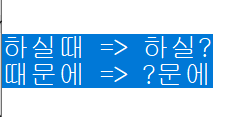There is no problem until you enter Korean and save the South Korean language.
-
There is no problem until you enter Korean and save the South Korean language.
There is a phenomenon that the text is broken when opened and closed.
I’m asking because I don’t know how to get help.

I’m using utf-8.
I am using notepad++ v8.7.
-
You provided a screenshot, but I am doubtful any of of the regulars here have enough experience with Korean to understand what you seem to think is wrong with the above. Maybe a better description will help.
But I will try some wild guesses, to see if I can be of some help to you.
Assuming you are trying to show that a few of the glyphs on the left are showing up as a
?in Notepad++:- if you did a bad encoding conversion, where the destination encoding didn’t have a codepoint for your source character.
- For example, if you took text
☺U+2640SMILE, and tried to use Encoding > Convert to ANSI, it would change from

to
? `U+2640` SMILE

because there is no glyph in ANSI for the ☺ smile character.
- For example, if you took text
- Similarly, if you tried to paste that text into a file that was already an ANSI file, it would do the same conversion to
? `U+2640` SMILE- so maybe you are trying to convert text into or paste text into an encoding that doesn’t have a codepoint for the Korean character that becomes the
?
- so maybe you are trying to convert text into or paste text into an encoding that doesn’t have a codepoint for the Korean character that becomes the
- Or maybe your chosen font for Notepad++ doesn’t include glyphs for those characters (but I think it would be an empty square box, not a question mark).
- Using Settings > Style Configurator > Global Styles > Default Style to pick a different font which you know has that glyph might solve the problem. (Or maybe changing the Settings > Preferences > MISC > ☐ Use DirectWrite and restarting Notepad++.)
- Or maybe it is showing something like
one�two– which would indicates that it was trying to decode some bytes from your file as a unicode character, but it wasn’t a valid unicode character, so it displays the � symbol to indicate a data input problem. This might indicate that your original file has some bad bytes (either because something was corrupted, or because the application that created your text file made a mistake).
- if you did a bad encoding conversion, where the destination encoding didn’t have a codepoint for your source character.